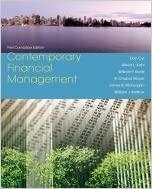1. Project X has an internal rate of return (IRR) of 12 percent. Project Y has an IRR of 14 percent. Both projects have a required return of 11 percent. Which of the following statements is most correct? A. Project Y must have a higher NPV than Project X. B. Project X has a lower profitability index than Project Y. C. Both projects have a positive NPV. D. Both projects have a negative NPV. 2. Which of the following statement regarding IRR is correct? A. If the net present value of a project is greater than zero, the firm's required rate of retum will be greater than its IRR B. If a project's IRR is greater than 0 pereent, the project should be accepted. C. If a project's IRR is greater than the cost of capital, the project should be rejected. D. The IRR rule states that you should take any investment opportunity where the IRR exceeds the cost of capital. 3. If a project has a positive net present value, then: A. the project's profitability index must also be positive. B. the project eams a return exactly equal to the cost of capital. C. the total of the cash inflows must exceed the initial cost of the project. D. the payback period must be equal to the maximum payback period set by the company. 4. If two mutually exclusive projects have different life spans, which of the following techniques should be use in the capital budgeting decision? A. Net present value (NPV) B. Profitability index (PI) C. Internal rates of retum (IRR) D. Equivalent annual annuity (EAA) 5. Cost of Capital is A. The minimum rate of return which the firm must eam on the equity share. B. The minimum cost to be paid to the equity shareholders. C. The minimum cost to be paid to the investor for inducing investors to subscribe to the capital. D. All the above 6. Two commonly used methods for estimating common stockholder's required rate of retum are: A. Dividend growth model and debt capital model B. Capital Assets Pricing Model and Dividend growth model C. Capital Assets pricing model and debt capital model D. None of the above options 7. Theory of capital structure focuses on the effect of of capital to the enterprise. A. Retained Earning B. Financial Leverage C. Common Stock D. Preferred stock 8. The pecking order hypothesis builds from the concept of A. Symmetric information B. Asymmetric information C. Confidential Information D. None of above 9. The pecking order hypothesis states that company usually proceed A. from internal funding to debt, and finally to equity. B. from debt to internal funding, and finally to equity C. from equity to debt and finally to internal funding D. without any preferred order 10. If the company employs 25% leverage in its capital structure, then it exposes its owners to financial risk. A. No B. Low C. Moderate D. Higher 11. Seasonal expansions in inventories and account receivables is called; A. Permanent Investment B. Temporary Investment C. Spontaneous Financing D. Temporary Financing 12. The the firm's use of current liabilities, other things being the same, the A. greater, greater B. lessor, lessor C. greater, lessor D. None of above








